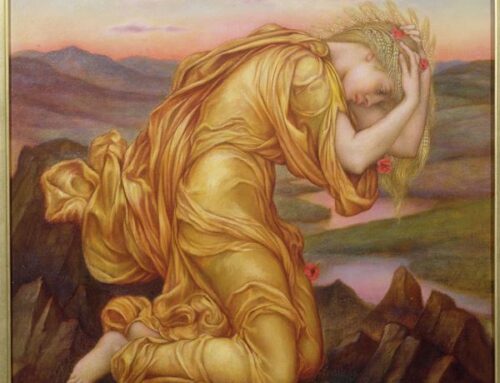Mary Evelyn Pickering (1855-1919) is often described as the wife of famous Arts and Crafts potter, William De Morgan. Indeed, her sister and biographer named her book of reminiscences on the couple as William De Morgan and his Wife. However, she was in fact a talented and pioneering female artist, who battled for recognition and respect in the male dominated Victorian art world.
As a young girl Evelyn, as she was known, was home schooled, with tutors to teach her the usual accomplishments of English, classics, music and of course art. Her talent for art was noted and she was encouraged by her uncle, artist John Roddam Spencer-Stanhope, to undertake professional training. Despite her uncle’s support, Evelyn had to fight against her wealthy parents’ expectations of being presented at court, formally ‘coming out’ to society and marrying well. Her diaries (De Morgan Collection archive) present a young ambitious woman, to engrossed in her art to be interested in such frivolities and fortunately her wealth meant marriage was not a necessity. On her seventeenth birthday, August 30th 1872, she writes:
…flittering time away I dread getting older, at the beginning of each year I say I will do something and then at the end I have done nothing, art is eternal but life is short …I will make up for it now, I have not a minute to loose
Evelyn first studied at the South Kensington National Art Training School (now the Royal College of Art) in London, before joining the Slade School of Art in 1873; becoming one of the first women to study there. Her talent was honed and recognised at the Slade and she won coveted prizes for her drawing skills in direct competition with her fellow male students.


Drawings from cast and life undertaken by Evelyn De Morgan at the Slade School of Art, De Morgan Collection.
Evelyn began exhibiting at the Dudley and Grosvenor Galleries in London soon after leaving the Slade. Both galleries were known for being particularly supportive of female artists. She chose not to exhibit at the Royal Academy whose work favoured classical and history subjects in a more traditional style. Early journalistic commentary of her work is favourable, and yet also expresses surprise regarding her status as a talented female. Her gender neutral first name appears to have aided this confusion. For instance a review in the Guardian (1876) of her first exhibited work states:
St. Catherine of Alexandria…by an artist named Evelyn Pickering who it is surprising for more reasons than one to find out is a lady… will not fail to assert its merits as an exceedingly well-posed, richly-coloured, and above all expressive figure.

Evelyn’s early work tended to draw from Evelyn’s classic knowledge and were in the popular Neo-Classical style favoured by artists such as Alma-Tadema and Lord Leighton. Her works sold for in the region of forty to sixty pounds – a not insignificant sum for an up and coming artist, albeit – less that a male artist would expect to receive.
At the height of her career her works had price tags of two to three hundred pounds attached and reviews of her work in the Art Journal and other such magazines often refer to her imagination and creativity, attention to detail, and skill as a colourist.
By the mid-1880s, Evelyn had become a regular exhibitor at the New Gallery (successor to the Grosvenor Gallery) despite dividing her time between London and Florence. Her approach had evolved to encompass the medieval inspired subjects and techniques made popular by the Pre -Raphaelites and she was directly inspired by the work of Botticelli and his contemporaries which she encountered on her many trips to Italy. This style also allowed her to choose subjects through which she could also express her political views.
For instance The Gilded Cage (1885 – 1919) below and The Prisoner (1907-8) right both contain female figures dressed in medieval inspired clothing, entrapped and isolated in domestic spheres. In The Prisoner the object of the painting remains passive. Whilst in The Gilded Cage the female figure expresses her frustration and wistfulness to belong to the outside world. Her entrapment is echoed by the caged bird at the top right of the painting.
Both works can be read as a commentary on Evelyn’s support of the suffrage movement: she and her husband were both signatories of the Declaration of Women’s Suffrage in 1889. Evelyn was aware that her wealth and status in society allowed her the ability to escape from many of societies norms. However, she was still constrained by Victorian morality. For instance, in order to preserve her reputation, her access to professional models was constrained and when she did draw from life, her male models typically wore modesty cloths.
Between 1909 and 1915 she did not exhibit at all, but she continued to paint and in 1916 compelled by the suffering caused by the First World War she mounted an exhibition of 13 works for the benefit of the Red Cross and the Italian Croce Rossa – the majority of these works had not been previously exhibited. Following Evelyn’s death her remaining works were sold to benefit St. Dunstan’s Charity for the Blind. Evelyn’s sister purchased a number of works from this sale, preserving her work for posterity and forming the nucleus of the De Morgan Collection as it is known today..









